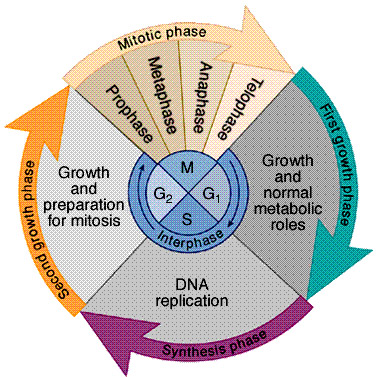
|

Links: |
Pet Shop Accident Julia stared into the salamander tank in horror. As an assistant in a pet shop, Julia had mistakenly put a small salamander in the same tank as a large one. Just as she realized her error, the large salamander attacked and bit off one of the small salamander’s limbs. Acting quickly, Julia scooped up the injured salamander and put it in its own tank. She was sure it would die before her shift ended. But she was wrong! Days passed…then weeks. Every time Julia checked on the salamander, she was more amazed at what she saw. 1. How do you think the salamander’s body reacts to losing its limb? 2. What cell processes do you think would be involved? _______________________________________ Why do cells divide? LIMITS TO CELL SIZE -Information overload: the information needed to complete biological processes, such as growth, are stored in genes located on DNA. As a cell increases in size, the demand on the DNA becomes greater. A cell that was too large would put too much demand on the DNA within the cell and the DNA would no longer be able to serve the needs of the growing cell. -Exchanging materials: food, water, oxygen, and other materials enter the cell through the cell membrane; waste products leave the same way. The rate at which this exchange of materials takes place depends on the surface area of the cell membrane, while the rate at which these materials are used depend on the volume of the cell. When a cell is too large, materials can’t be exchanged fast enough to service the volume of the cell. How does cell division solve these two problems? Before it becomes too large, a growing cell divides, forming two “daughter” cells. The process by which a cell divides into two daughter cells is called cell division, or mitosis. Before cell division occurs, the cell “replicates”, or copies all of its DNA. This replication of DNA solves the problem of information overload, because each new (& smaller) cell receives one complete copy of the genetic information, DNA. Cell division results in two smaller cells, with smaller surface area to volume ratios. So materials can be exchanged efficiently. >>>>>>>>>0. Summarize, in your OWN words, two reasons why cells can't become too large, and how cell division solves these problems. ______________________________________ The Cell Cycle & Cell Division Use the 1st link to answer question 1. 1. Fundamental info: What are chromosomes? Use the 2nd link to answer question 2. Prokaryotic Cell Cycle & Division (Asexual Reproduction: Binary Fission) The prokaryotic cell cycle is a regular pattern of growth, DNA replication, and cell division that can occur very rapidly under ideal conditions. Little is known of the details of the cell cycle in prokaryotes. It is known that most prokaryotic cells begin to replication, or copy, their DNA once they have grown to certain size. When DNA replication is complete, the cell begins to divide. 2. Describe what occurs during prokaryotic cell division (a form of asexual reproduction called binary fission). Use the 3rd link & image on the top of THIS page for questions 3-5A. Eukaryotic Cell Cycle & Division 3. What are the TWO major “sections” of the cell cycle? 4A. Briefly describe what events occur during the three steps of the cell cycle (G1, S, and G2). 4B. What occurs during GO and why? 5A. What occurs during M (mitosis phase) of the cell cycle? Use links numbers 4 and 5 to answer questions 5A, 5B & 5C. 5B. Briefly list events of what occurs during the steps of mitosis in terms of chromosomes (metaphase, prophase, anaphase, and telophase - there are more but these are enough for us). 5C. Summarize cytokinesis. |